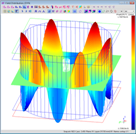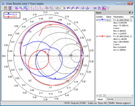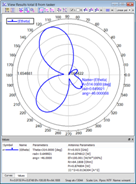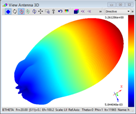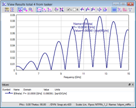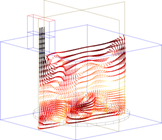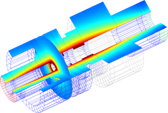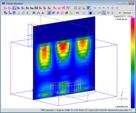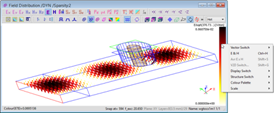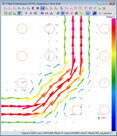various display types for field distribution viewing (quasi-three-dimensional, fields intensity represented by colours, vector form)
linear and decibel scales
automatic and manual scales
one and two dimensional displays
two dimensional displays available for each cells layer
3D presentation of the antenna radiation pattern
3D presentation of the field components distribution, currents, material parameters etc. using QViewer module
instantaneous and envelope (i.e. time-maximum and time-averaged) values of the displayed component
fields (E and H field components), Poynting vector and power dissipated distribution available at any simulation stage (time domain monitoring)
fields (E and H field components), Poynting vector and power dissipated distribution for real and imaginary grids, available for the periodic structures
temperature and enthalpy distribution for microwave heating problems
effective media parameters distribution
watching field components along a specified line in space/versus time/along pre-defined contour
virtual measurements of attenuation and SWR
Time-Domain Reflectometry results (with virtual measurements of reflection coefficient and location of the discontinuity)
power dissipated and energy stored in electric and magnetic field, and the resultant Q-factor calculations (also for real and imaginary grids for periodic structures)
power dissipated and stored energy calculations for the entire lossy volume or in the specified objects
energy dissipated over the entire duration of a pulse of limited duration (power dissipated integration in time)
linear, decibel, and quadratic (for S-parameters, radiation and scattering patterns) scales
automatic and manual scales
loading reference results for S-parameters, radiation and scattering patterns
reflection coefficient calculations for several ports simultaneously, during a single simulation run (applicable for multi-source networks when N sources operate simultaneously, and consequently the S-matrix cannot be calculated)
virtual shift of the “reference plane” (the plane where the S-parameters extraction is performed)
frequency dependent wave impedance (reference impedance for S-parameters calculations) and propagation coefficient of transmission lines
power balance calculation
standing wave ratio (SWR) and group delay calculations
S-parameters embedding and deembedding
antenna radiation patterns and scattering patterns of a scattering structures for wide angle range, at multiple frequencies, for any plane
gain (directive, power, absolute, relative, fields scaled to 1m), radiation efficiency, radiation resistance and radiated power calculations
radiation patterns for linear and circular polarisation
radiation patterns for antenna arrays
radiation pattern at a chosen near-to-far transformation (Huygens) surface
far field 3D radiation patterns calculations
radiation pattern calculations in an arbitrary isotropic medium
radiation patterns for a specified directions versus frequency
impulse response in the far-field
Fourier transforms of terminal voltage across/current through resistor at any circuit point
Fourier transforms of field integrals along defined contours
power available from the source calculations (Fourier transform of the excitation waveform)
energy available from the source





